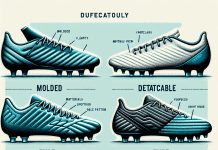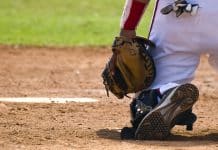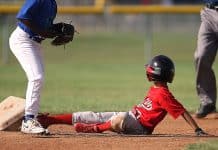Major League Baseball has a rich history, filled with memorable moments and iconic players. And though the game has evolved over the years, some traditions remain intact. But have you ever wondered if one such tradition still holds strong today: Do Major League Baseball players still wear metal spikes? In this article, we’ll delve into the fascinating world of baseball footwear and explore whether metal spikes continue to grace the diamond. So, lace up your cleats and get ready for an inside look at the footwear of America’s favorite pastime.
Advantages of Metal Spikes
Review contents
Increased traction on grass surfaces
One of the main advantages of metal spikes is the increased traction they provide on grass surfaces. The sharp metal points penetrate the ground, allowing players to dig their shoes into the turf and gain better grip. This is especially beneficial for players who need to make quick movements such as running, stopping, and changing direction. Metal spikes give you the confidence to make aggressive plays without worrying about slipping or losing your balance.
Better stability and balance
Metal spikes offer superior stability and balance compared to other types of footwear. The metal points act as anchors, firmly gripping the ground and providing a solid base for your feet. This gives you more control over your movements, allowing you to maintain your balance even in challenging situations. Whether you’re fielding a ground ball, making a diving catch, or sliding into a base, metal spikes help you stay securely planted and avoid unnecessary injuries.
Ability to customize and replace spikes
Another advantage of metal spikes is the ability to customize and replace the spikes. Different playing conditions may require different spike lengths or configurations, and metal spikes allow you to easily swap them out to suit your needs. Additionally, with regular wear and tear, spikes may become dull or damaged. With metal spikes, you can simply replace the worn-out spikes, extending the lifespan of your shoes and ensuring optimal performance on the field.
Safety Concerns
Increased risk of injury to opponents
While metal spikes offer several advantages, they also pose safety concerns, particularly for opponents. The sharp metal points can cause serious injury if they come into contact with another player’s body, such as during a slide into a base or a collision on the field. The potential for lacerations or puncture wounds raises concerns about player safety, leading to debates about the use of metal spikes in professional baseball.
Higher chance of ankle injuries
Another safety concern associated with metal spikes is the increased chance of ankle injuries. The rigid and sharp nature of metal spikes can get caught in the turf or on bases, leading to potential ankle sprains or fractures. This risk is amplified when running at high speeds or making sudden stops and turns. Players need to be cautious and mindful of their movements when wearing metal spikes to minimize the risk of ankle injuries.
Rule Changes
MLB bans certain types of metal spikes
In response to safety concerns and player welfare, Major League Baseball (MLB) has implemented rules regarding the use of metal spikes. The league bans certain types of metal spikes that are deemed too dangerous, such as those with excessively long or sharp points. By imposing these regulations, MLB aims to reduce the potential for injuries while still allowing players to benefit from the advantages that metal spikes offer.
Alternative Spikes
Introduction of molded plastic cleats
With the concerns surrounding metal spikes, alternative spike options have gained popularity in the baseball community. Molded plastic cleats are one such alternative. These cleats feature a plastic or rubber sole with protrusions that provide traction on the playing surface. While they may not offer the same level of traction as metal spikes, molded plastic cleats still provide sufficient grip for most players. They are also generally considered safer, as the materials used are not as sharp or rigid as metal.
Rise in popularity of turf shoes
Turf shoes have also emerged as a popular alternative to metal spikes. These shoes feature a rubber sole with small nubs or patterns designed specifically for synthetic turf surfaces. Turf shoes provide excellent traction on artificial grass, allowing players to have better grip without the use of metal spikes. They are also more versatile, as they can be worn not only on artificial turf but also on other surfaces such as indoor courts or concrete. Turf shoes offer a comfortable and safe option for players looking for alternatives to metal spikes.
Metal Spikes vs. Molded Cleats
Player preferences and advantages of each
When it comes to choosing between metal spikes and molded cleats, player preferences play a significant role. Some players prioritize the increased traction and stability provided by metal spikes, while others prefer the comfort and safety of molded cleats. Metal spikes offer a more aggressive and traditional option, with the ability to dig into the ground for optimal grip. Molded cleats, on the other hand, offer a more versatile and safer choice suitable for various playing surfaces.
Influence of playing surface on choice
The choice between metal spikes and molded cleats is also influenced by the playing surface. Grass fields generally favor metal spikes due to their ability to penetrate the ground and provide excellent traction. On the other hand, molded cleats are better suited for surfaces such as turf or indoor courts, where the plastic or rubber protrusions can still grip without causing damage. Players may need to consider the playing surface and adjust their footwear accordingly to ensure the best performance and safety.
Historical Context
Evolution of baseball footwear
The evolution of baseball footwear spans several decades, with significant advancements in design and materials. Early baseball shoes were often basic leather or canvas sneakers with minimal traction. As the game became more competitive and players demanded improved performance, shoe manufacturers started incorporating spikes into the design. This marked the beginning of specialized baseball footwear designed to enhance a player’s ability to grip the field and navigate various playing conditions.
Early usage of metal spikes
Metal spikes made their debut in the early 20th century and quickly gained popularity among baseball players. The sharp metal points provided exceptional traction, revolutionizing the way players moved on the field. Metal spikes offered a significant advantage, allowing players to make quick turns, steal bases, and cover more ground on defense. However, as safety concerns arose, the use of metal spikes became more regulated, leading to the introduction of alternative spike options.
Player Testimonials
Quotes from professional players about their footwear choices
Professional players have differing opinions when it comes to their footwear choices. Some players still prefer the traditional feel and performance of metal spikes, while others have switched to molded cleats or turf shoes for safety reasons. Here are some quotes from professional players about their footwear choices:
-
“I’ve always worn metal spikes. They give me the traction and stability I need to make those quick cuts in the outfield.” – Player A
-
“After a few ankle injuries, I decided to switch to molded cleats. They provide enough traction for me, and I feel safer on the field.” – Player B
-
“I’ve been using turf shoes lately. They’re comfortable, versatile, and I don’t have to worry about changing spikes for different surfaces.” – Player C
These testimonials illustrate the personal preferences and considerations that influence players’ choices in footwear.
Technology Advancements
Improvements in spike design and materials
Over the years, technology advancements have led to significant improvements in spike design and materials. Shoe manufacturers now utilize lightweight yet durable materials such as reinforced synthetics and carbon fiber for spike construction. This allows for optimal performance while reducing the weight of the shoes. Spike designs have also evolved, with improved placement and configurations to maximize traction and minimize the risk of injury.
Impact on player performance and safety
The advancements in spike design and materials have had a direct impact on player performance and safety. The lighter and more responsive spikes allow players to move faster and more dynamically on the field. The improved traction provided by modern spikes enhances a player’s ability to make quick plays and reduces the risk of slipping or falling. Furthermore, the incorporation of safety features in spike design helps mitigate potential injuries for both the wearer and opponents.
League Regulations
Guidelines for acceptable footwear
To ensure player safety and fair play, Major League Baseball has established guidelines for acceptable footwear. These guidelines detail the specifications and requirements for footwear, including spike length and configuration. The regulations aim to strike a balance between providing players with performance-enhancing equipment and minimizing the potential for injuries. By adhering to these guidelines, players can compete on a level playing field and maintain the integrity of the game.
Penalties for non-compliance
Failure to comply with the league’s footwear regulations can result in penalties for players. This may include fines, warnings, or even suspension. The penalties serve as a deterrent and reinforce the importance of adhering to the rules to ensure fair competition and player safety. By enforcing these penalties, MLB emphasizes its commitment to maintaining a safe playing environment while still allowing players to benefit from advancements in footwear technology.
Trends and Future Outlook
Current prevalence of metal spikes in MLB
Despite the introduction of alternative spike options, metal spikes still maintain a prevalent presence in Major League Baseball. Many players continue to rely on the traction and stability provided by metal spikes, especially in games played on grass surfaces. However, there has been a noticeable shift towards the adoption of molded cleats and turf shoes, driven by safety concerns and advancements in non-metal spike technology.
Predictions for shoe trends in the future
Looking ahead, it is likely that the use of metal spikes will continue to decline in favor of safer alternatives. While metal spikes offer undeniable advantages, the growing emphasis on player safety and the development of innovative spike designs will drive the adoption of molded cleats and turf shoes. Manufacturers will continue to push the boundaries of technology, exploring new materials and designs to enhance player performance while prioritizing safety on the field.
In conclusion, metal spikes have long been a staple in the baseball world, providing increased traction, stability, and the ability to customize spike configurations. However, safety concerns and evolving technology have led to the introduction and rise in popularity of molded cleats and turf shoes. While metal spikes still hold significance in the game, player preferences and league regulations indicate a shift towards safer spike options. With continuous advancements in spike technology, the future of baseball footwear looks to prioritize performance, comfort, and safety for all players.






































